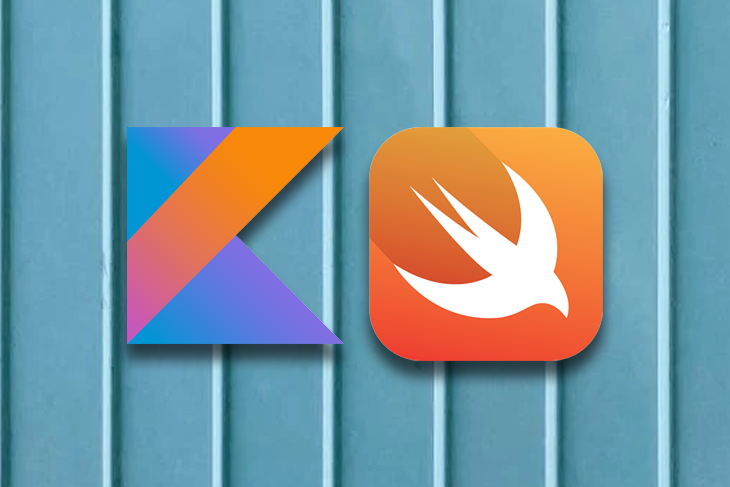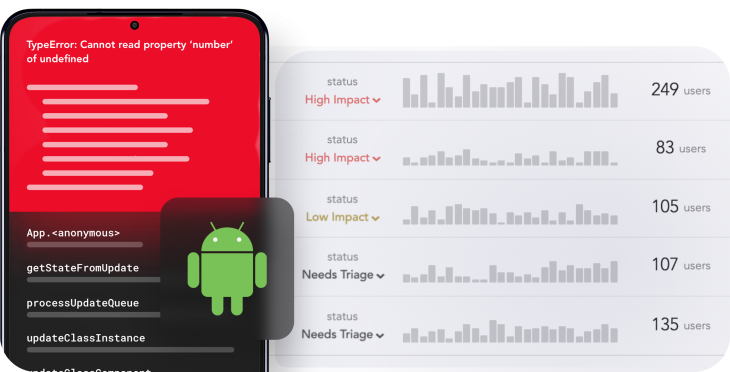
Control flow statements employ decision-making to conditionally execute particular blocks of code and are used to break up the typical top-to-bottom flow of execution. Some examples of these kinds of statements are the well-known if-else statements, looping statements like for or while, and the more versatile switch or when statements.

In this article, I will compare the traditional switch statement found in the Swift programming language and the similar when statement found in Kotlin.
Both control flow statements define a conditional expression with multiple branches, then sequentially match their arguments against all branches until some branch condition is satisfied. Finally, they execute the matched branch’s block of code and continue executing any subsequent pieces of code.
To jump ahead in this article:
The Replay is a weekly newsletter for dev and engineering leaders.
Delivered once a week, it's your curated guide to the most important conversations around frontend dev, emerging AI tools, and the state of modern software.
switch and when statements in Swift and KotlinWhile Swift and Kotlin have many differences, there are some similarities that both their switch and when control flow statements share.
The most obvious similarity between both the switch and when control flow statements is the default case.
Swift’s switch statement simply inherits the default keyword from its C predecessors, while Kotlin instead opts to use the divergent but well-known else keyword in order to define the default case of its modern when statements.
Here’s an example of a switch statement in Swift:
switch (expression) {
case value1:
// content
case value2:
// content
...
default:
// content of default case
}
And here’s an example of a when statement in Kotlin:
when (expression) {
value1 -> //content
value2 -> //content
...
else -> // content of default case
}
Both of these statements can be actively substituted by a series of if-else-if statements, where the trailing else statement serves as the default case. Nevertheless, both the switch and when statements achieve the same as an if-else statement with multiple branches, but with less code and more simple syntax:
if (expression == value1) {
// content
} else if (expression == value2) {
// content
...
} else {
// content of default case
}
Conversely, both conditional statements can use any kind of native data type as the body or expression to use for comparison within the branches.
Some examples of the different data types they can use include Integer, Double, Char, and String types.
Here’s an example of a switch statement comparing a Character type in Swift:
let charToCompare: Character = "i"
switch someCharacter {
case "a":
// content
case "i":
// content
case "n":
// content
case "v":
// content
}
Additionally, both of these statements support the use of the Enumeration type, also known as enum, as the conditional expression used for comparison.
Here’s an example of a when statement comparing an enum type in Kotlin:
enum class Color { BLUE, PURPLE, BLACK, GOLD }
when (getColor()) {
Color.BLUE -> // content
Color.PURPLE -> // content
Color.BLACK -> // content
Color.GOLD -> // content
}
Notice that in the example above, all cases of the enumeration are exhausted. This allows us to omit the default case, which would have been an else branch.
Another similarity that when and switch share is the ability to use numeric ranges as the values to compare against the provided expression.
Here’s an example of a switch statement using a numeric range in Swift:
let count = 42
switch count {
case 0..25:
// content
case 26..50:
// content
case 51..75:
// content
case 76..100:
// content
default:
// default case content
}
And here’s an example of a when statement using a numeric range in Kotlin:
val count = 42
when (count) {
in 0..25 -> // content
in 26..50 -> // content
in 51..75 -> // content
in 76..100 -> // content
else -> // default case content
}
switch and when statementsWith both the switch and when statements, it is also possible to group more than one case in the same conditional branch by simply separating all additional conditions with a comma.
Here’s an example of a when statement capturing multiple cases in one branch in Kotlin:
val x = 6
when (x) {
in 1, 2 -> // content
in 3, 4 -> // content
in 5, 6 -> // content
else -> // default case content
}
Another powerful similarity that both when and switch share is the ability to check for inheritance. We can do this by checking what kind of object we’re dealing with, as long as the expression to compare is an instance of a superclass.
Here’s an example of a switch statement checking for object type in Swift:
let vehicle: Vehicle = Car()
switch vehicle {
case is Car:
// content
case is Motorcycle:
// content
case is Tricycle:
//content
} // where Car, Motorcycle & Tricycle all extend the Vehicle class
switch and when statementsThe last similarity that we’ll go over is something that both expressions can do because of the functional programming patterns that both Swift and Kotlin have integrated into their language libraries.
We can use either switch or when statements as the assignment of a variable, where both will take the result they’re arriving at and use it as the value for any kind of variable.
Here’s an example of a when statement being assigned to a variable in Kotlin:
val seasonOfTheYear: String = when (getMonthByNumber()) {
3, 4, 5 -> "Spring"
6, 7, 8 -> "Summer"
9, 10, 11 -> "Autumn"
12, 1, 2 -> "Winter"
}
switch and when statementsWhile there are a lot of similarities between Swift’s switch and Kotlin’s when statements, they also have some fundamental differences, thanks to the unique features of their respective programming languages.
switch statementThe first difference worth noting between switch and when is that while Swift’s switch statement has to be exhaustive at all times, and while adding a default branch may be enough to make it exhaustive at the compiler level, this is not the case for Kotlin’s when statement.
The Kotlin when statement is only required to be exhaustive when it is used as an expression — for example, whenever it gets assigned to a variable, or where an else branch may be used to capture a default behavior. On the other hand, whenever the when pattern is used as a statement, it behaves as a regular if-else-if statement, where all branches of the conditional block will be assessed, but no branch will execute unless there’s a match.
Fallthrough cases in Swift and KotlinGetting back into code, a big distinction between the switch and when expressions is the use of the fallthrough keyword.
The fallthrough behavior in Swift works a lot like it does in a C-based language. For example, in the Java code block below, omitting the break keyword triggers the fallthrough behavior by executing the code that is contained by the next conditional branch of the switch statement.
final int x = 6;
switch {
case 1, 2:
// not executed
break;
case 3, 4:
// not executed
break;
case 5, 6:
// executed
case 7, 8, 9:
// also executed because it will fall through
break;
}
In contract, Swift switch statement requires a special keyword, namely fallthrough, to indicate that we want any given conditional branch of a switch statement to fall through onto the next one and execute the code that is in there as well.
Here’s an example of a switch statement with fallthrough behavior in Swift:
let x = 6
switch x {
case 1, 2:
// not executed
case 3, 4:
// not executed
case 5, 6:
// executed
fallthrough
case 7, 8, 9:
// also executed because it will fall through
}
when advantage: Conditional statement with an empty expressionMoving over into the Kotlin scene, the when statement has an advantage: it can be used with an explicit body or expression, allowing it to enter a typical if-else-if pattern, but with a much cleaner syntax.
Whenever taking this approach, the else branch is also available as a default case, but it’s not required in all cases.
Here’s an example of a when statement with an empty expression in Kotlin:
when {
x.isOdd() -> // content
x.isEven -> // content
else -> // default case content
}
Bonus: There is a hacky way of achieving this in a
switchstatement where you simply passtrueas your expression and go over each branch one by one, but this case shouldn’t be chosen over a regularif-else-iftree of expressions.
switch statement’s expressionThe last difference between when and switch we’ll cover comes from a pattern deeply engrained into Swift that comprises passing a tuple as the switch statement’s expression.
Although this data structure type is similar to a regular Java or Kotlin Pair, it does not directly support when statements receiving this as their expression, and it is not used in the same way that Swift uses it by comparing two values at once.
Here’s an example of a switch statement using a tuple in Swift:
let coordinates = (0, 1)
switch coordinates {
case (0, 0):
// point is at the center
case (_, 0):
// point is on the x-axis
case (0, _):
// point is on the y-axis
}
It’s no secret that while Swift built upon the traditional usage of switch statements from C-based languages, Kotlin went a bit astray by transforming its when statement with conditional branching.
However, these statements share many similarities while also sporting differences based on the patterns and paradigms supported by each of their programming languages.
At the end of the day, both switch and when statements should be used with the same goal in mind: to break out of the usual top-to-bottom sequence of execution and to add decision-making, flexibility, and versatility to our classes.
LogRocket is an Android monitoring solution that helps you reproduce issues instantly, prioritize bugs, and understand performance in your Android apps.
LogRocket's Galileo AI watches sessions for you, instantly identifying and explaining user struggles with automated monitoring of your entire product experience.
LogRocket also helps you increase conversion rates and product usage by showing you exactly how users are interacting with your app. LogRocket's product analytics features surface the reasons why users don't complete a particular flow or don't adopt a new feature.

Start proactively monitoring your Android apps — try LogRocket for free.

AG-UI is an event-driven protocol for building real AI apps. Learn how to use it with streaming, tool calls, and reusable agent logic.

Frontend frameworks are often chosen by default, not necessity. This article examines when native web APIs deliver better outcomes for users and long-term maintenance.

Valdi skips the JavaScript runtime by compiling TypeScript to native views. Learn how it compares to React Native’s new architecture and when the trade-off makes sense.

What trends will define web development in 2026? Check out the eight most important trends of the year, from AI-first development to TypeScript’s takeover.
Would you be interested in joining LogRocket's developer community?
Join LogRocket’s Content Advisory Board. You’ll help inform the type of content we create and get access to exclusive meetups, social accreditation, and swag.
Sign up now